No One Left Behind and the Young Person's Guarantee: implementation evaluation
The evaluation explores how effectively No One Left Behind and the Young Person’s Guarantee had been implemented, the experiences of service providers and service users, and lessons from early delivery. The evaluation took place between May and December 2022.
5. Experiences of service users
Key Findings
- The most common referral routes into employment services are the Job Centre (for those aged 25+) and careers advisers (for those under 25).
- Most service users were looking for support to help find a job, but many were also looking for other types of support including to build confidence or access careers advice, training, apprenticeships, work experience or support to remain in work.
- Service users accessed a wide range of services, with support for CV development, one-to-one support from a key worker and job search support being the most common.
- Most service users found it easy to access employment support services. The most common reasons given for service users finding services easy to access were that staff were friendly, approachable, supportive and encouraging.
- The small number of people who found services difficult to access referenced the services not been well advertised or well-known and challenges faced in making contact, including phones not being answered, being kept on hold or people not getting back to them.
- Service users were experiencing a wide range of challenges and barriers to progression at first engagement with the service, with low confidence / self-esteem and mental health and wellbeing issues being the most common.
- Service users reported high levels of satisfaction with the support they received due to the holistic, tailored and person-centred nature of this and how open, supportive and encouraging the staff were.
- Most service users agreed that the support received was delivered by knowledgeable staff, made communications simple and clear, was tailored to their needs, recognised their existing experience and current situation and were easy to access and engage with
- Key themes amongst those who were dissatisfied with the service related to the time taken to access particular types of support and a lack of responsiveness, with some thinking that services seemed understaffed (in line with feedback from some providers).
- Around half of service users had been asked by the employment support service to provide feedback on the services they received, and around half said they knew how to complain if they were unhappy with the support received.
5.1 Introduction
This chapter reports on the experiences of services users who have accessed employability support in Scotland since 2019. It begins with an overview of service users' engagement with employment support services, followed by feedback on their experiences of this, including the extent to which it met their needs. The chapter then presents self-reported outcomes for service users from the support received and their views on potential recommendations for future services. The findings draw on evidence from the online survey, depth interviews and online diaries with service users. The survey results are presented for those under the age of 25 (who would have received support through the Young Person's Guarantee) and those over the age of 25 who would have received support under the wider banner of No One Left Behind.
5.2 Engagement with employment support services
Timing and volume of engagements with services
Most of the service users who participated in the evaluation had accessed employment support services in the preceding two years. Of those who completed the online survey, more than half (58%) had accessed employment support services in 2022 and over a quarter (28%) had accessed services in 2021. A lower share of respondents had accessed services in 2020 and 2019 (13% and 8% respectively).
Employment support services in Scotland work with a lot of repeat service users. Two fifths (41%) of service users who responded to the survey had accessed employment services once. A similar proportion (39%) had accessed services on more than one separate occasion, with 12% having accessed services more than five times. A fifth (20%) couldn't remember how many times they had accessed services (Figure 5.1).
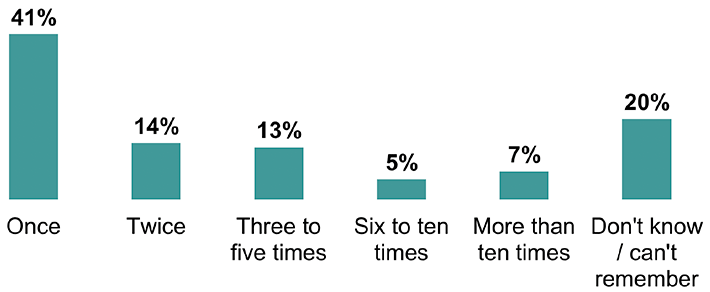
Source: Ipsos survey of service users
Base: All (713)
Respondents were asked to answer this question in relation to the number of different occasions they had accessed employment support rather than the number of individual contacts they had with the service.
First engagement with services
The most common referral routes into employment support services are the Job Centre (for those aged 25 and over) and careers advisers (for those aged under 25). Overall, a third of service users (33%) had heard about employment support services through the Job Centre and one in every seven had heard about the services from friends or family (14%) or a careers advisor (14%). Figure 5.2 shows that those aged 25 and over were most likely to have heard about the services through the Job Centre, whilst those aged under 25 were more likely to have heard about them through a careers advisor.
Those under the age of 25 were also more likely to have heard about the services from friends or family or through school / college. Those over the age of 25 were slightly more likely to have heard about the services through social media, an employer, previous engagement with the service or a council website although the proportions for each of these were much lower.
Interviews with service users who had accessed support delivered through their local authority said they had previously been unaware that these services were available. They described being unemployed and/or out of education for a while before friends or family made them aware that there was support available. It was suggested by service users that more could be done to raise awareness of the services that are available in order to reach more people who could benefit from the support.
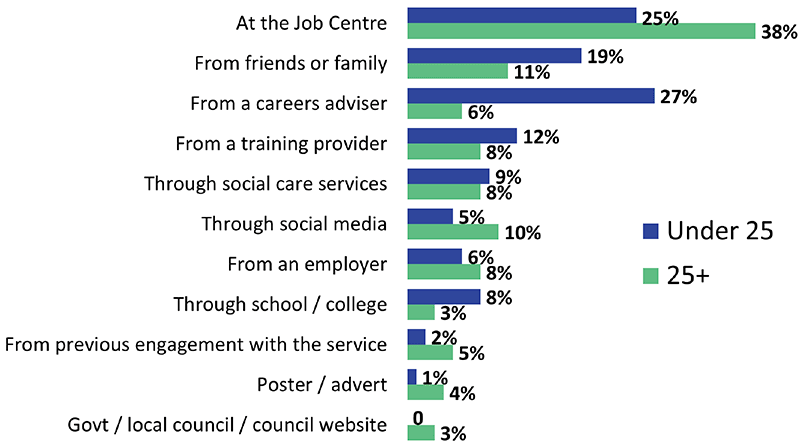
Source: Ipsos survey of service users
Base: Under 25 (271); Over 25 (433)
There were some significant differences found in how different groups of service users first heard about the services they accessed:
- Service users over the age of 55 were more likely to have heard about the services through the Job Centre (54% relative to 33% overall)
- Those from a white ethnic background were more likely to have heard about the services through the Job Centre than those from a minority ethnic background (34% relative to 22%)
- Those who were care experienced were more likely to have heard about the services through social care services than those who were not care experienced (13% relative to 8%)
- Single parents were less likely to have heard about the services through friends and family, careers advisors or from a training provider compared to those who were not single parents.
Motivations for engagement
Most service users were looking for support to help find a job, but many were also looking for other types of support to address barriers to progression. Around two thirds of survey respondents were hoping for support to find a job (63% for those aged under 25; 66% for those aged 25 and over). The second most frequently mentioned reason for accessing services was to build confidence, cited by two in every five respondents. Service users who were under the age of 25 were more likely to be looking for support to access apprenticeships, whilst those aged 25 or over were more likely to be looking for support to access training (Figure 5.3).
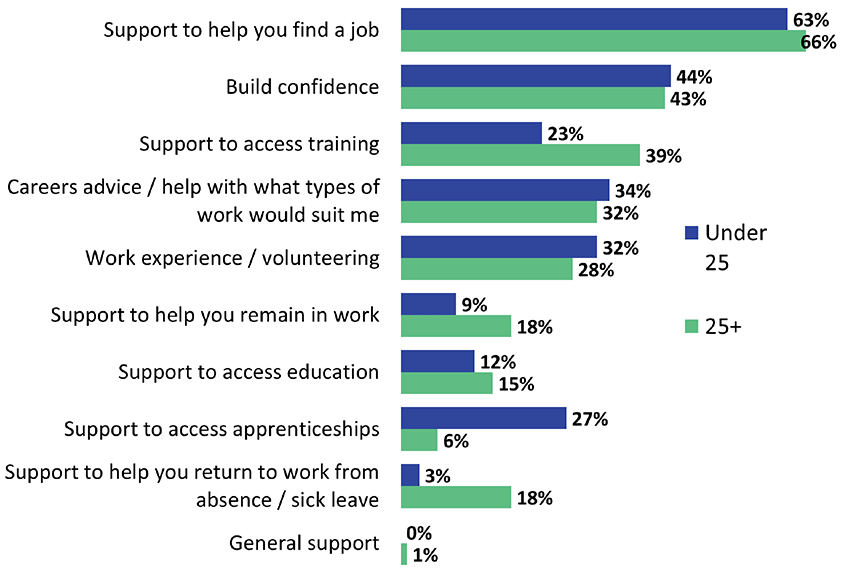
Source: Ipsos survey of service users
Base: Under 25 (271); Over 25 (433)
Access to support to build confidence also emerged as a key theme in the interviews with service users. There were examples of women who wanted to return to the labour market after time away to have children and were looking for support to build their confidence. There were also examples of people over the age of 50 who were lacking confidence to pursue opportunities that they thought would be unavailable to them due to their age or where they would need to consider retraining.
Almost one in ten (9%) service users under the age of 25 and two in ten (18%) of those over the age of 25 had accessed support to help remain in work. The interviews and online diaries with service users did not identify any notable differences in the experiences of those who had accessed in-work support and those who had not.
Types of employment support accessed
Service users accessed a wide range of services, with support for CV development, one-to-one support from a key worker and job search support being the most common. Just over half of service users accessed support for CV development and just under half accessed job search support. Those aged 25 or over were more likely to have accessed one-to-one support as well as support for education or training (Figure 5.4). Those under the age of 25 were more likely to have accessed support for interview skills and attended group sessions to develop employability skills. They were also more likely to have accessed mental health support and support to access an apprenticeship.
There were significant differences in the types of services accessed by service users with a disability. People with a disability were less likely to have accessed job search support (42% relative to 51% of those without a disability), less likely to have accessed careers information, advice and guidance (28% relative to 35%) and less likely to have accessed support for an apprenticeship (7% relative to 14%). Service users with a disability were more likely to have accessed support for volunteering or a work placement (33% relative to 21%), mental health support (30% relative to 11%) and support to put in place a reasonable adjustment at work (10% relative to 4%).
Looking at differences in support accessed by other characteristics, men were more likely than women to have received support to access a volunteering or work placement (29% relative to 21%). Those from a white ethnic background were more likely to access mental health support than those from an ethnic minority background (19% relative to 9%) and single parents were more likely to access one-to-one support from a key worker compared to all service users (71% relative to 55%).

Source: Ipsos survey of service users
Base: Under 25 (271); Over 25 (433)
Service users who participated in interviews also referenced a wide range of different types of support they had accessed through the service. This included funding towards the cost of training, travel to attend interviews, clothes to attend interviews or for starting a new job, and for childcare costs. Some also received phones and iPads to address digital exclusion, which they used for job searches, to create CVs, complete online training and apply for jobs. Others received money advice, help finding accommodation, support with anxiety issues (including to use public transport) and help with getting doctors' appointments. Service users appreciated that that the range of support available to them went beyond a narrow focus on employability or employment issues to encompass wider issues they were facing in their lives.
"She's amazing, really understanding, because I was so paranoid about leaving the house…she helped me, supported me and gave me advice about what to do and not to do."
(Service user)
"The money advice guy did the calculations for better off in work and I couldn't believe how much better off I'd be in work, even with a part time job. He really showed that it would be perfect."
(Service user)
"I've been in the local library today using the computers to do a bit of research to see what courses I may be able to do using the ITA SDS £200 payment that you are able to apply for once a year. I have done this before and took a First Aid course but I've been looking at things that are perhaps a bit more specific for truck driving."
(Service user)
Accessibility of services
Service users were asked how easy or difficult they found it to access employment support services. Those aged 25 and over were more likely to say they found it very easy (Figure 5.5). Around three quarters (72%) of those aged under 25 found it very or fairly easy to access services. This increases to 80% for those aged 25 and over. A higher proportion of those under the age of 25 thought it was neither easy or difficult (17% relative to 11%). The proportions of service users who found it difficult to access services was very low (2% of those under the age of 25 and 5% for those aged 25 and over).
The most common reason given for service users finding services easy to access were that staff were friendly, approachable, supportive and encouraging. The small number of people who found services difficult to access referenced the services not been well advertised or well-known and challenges faced in making contact, including phones not being answered, being kept on hold or people not getting back to them.
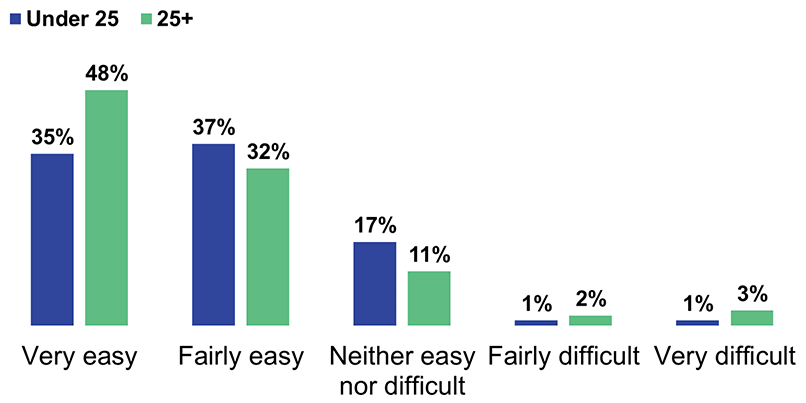
Source: Ipsos survey of service users
Base: Under 25 (271); Over 25 (433)
A significantly higher percentage of service users over the age of 55 found it difficult to access services compared to those under the age of 25, although the proportion who thought this was still low overall (7% relative to 2% across all service users). Service users over the age of 55 were more likely to think that staff were not helpful, supportive or knowledgeable and that the service was not tailored or suited to their needs and age.
A significantly higher percentage of disabled people or people with a long-term health condition found it difficult to access services compared to service users without a disability or long-term health condition (6% relative to 2%), although again the proportion who thought this was still relatively low. Respondents in this group were more likely to think that the services were not well advertised or known, that communication was poor, and they didn't feel listened to.
There were no significant differences observed between people from different ethnic backgrounds, people who were care experienced, single parents or service users with a conviction.
A significantly lower proportion of service users reported that accessing services was difficult in 2021 (3%) and 2022 (2%) compared to 2019 (11%). This would suggest some improvement in accessibility of services over this time period. Looking at this in more detail:
Service users who accessed support in 2019 were more likely to say that staff were not helpful, supportive or knowledgeable than those who accessed services in 2022 (7% relative to 1%)
Service users who accessed support in 2019 were more likely to say that they received poor guidance or support to get a job or work placement than those who accessed services in 2022 (5% relative to 1%).
Those service users who found it was easy to access support discussed flexibility in scheduling appointments and being offered both online and in-person support as key factors.
"The advisor was happy to work around my schedule and school. Telephone appointments during the pandemic worked well. I could get my daughter and still have the appointment."
(Service user)
"They made it easy and told you what support you could access. I liked that they weren't in an office building, we met in a cafe."
(Service user)
"Much better virtual, it would have been difficult in person as I don't drive and live in a little village."
(Service user)
Barriers to progression
Service users were experiencing a wide range of challenges and barriers to progression in the labour market at first engagement with the service. Around half of survey respondents (51%) reported experiencing low confidence / self-esteem and two fifths (38%) reported experiencing mental health and wellbeing issues at first engagement with the service (Figure 5.6). Young people under the age of 25 were more likely to be lacking work experience or skills or qualifications. Those aged 25 and over were more likely to be experiencing worries about money, childcare or caring responsibilities preventing them from accessing training or work, lack of access to transport or housing issues. This analysis highlights the wide range of barriers that service users are likely to be facing to progressing and key differences in the support needs of those under and over the age of 25.

Source: Ipsos survey of service users
Base: Under 25 (271); Over 25 (433)
Low confidence / self-esteem was significantly more likely to be reported as an issue by disabled service users or service users with a long-term health condition compared to those without a disability or long-term health condition (65% relative to 41%). Low confidence / self-esteem was also reported by a significantly higher proportion of service users from a white ethnic background compared to an ethnic minority background (52% relative to 30%). The same trends were observed in relation to mental health and wellbeing, with 63% of disabled service users or service users with a long-term health condition reporting that they were experiencing this at first engagement with the service compared to 24% of service users without a disability or long-term health condition. Similarly, 41% of service users from a white ethnic background reported experiencing mental health and wellbeing issues at first engagement compared to 17% for those from an ethnic minority background.
Lack of suitable employment or training opportunities was reported as a key challenge by a significantly higher proportion of those who responded to the survey who:
- Were men rather than women (38% relative to 28%)
- Had a disability or long-term health condition (40% relative to 31% who did not)
- Had a conviction (51% relative to 32% who did not).
Worries about money at first engagement with the service were more frequently reported by single parents (47%) and service users with a conviction (63%) relative to all survey respondents (34%).
Childcare responsibilities preventing access to training or work was reported as an issue by 53% of single parents; 25% women and 5% men. One service user was both a parent and a carer for their parents, which created challenges in attending sessions.
Access to transport was a key issue raised by service users who participated in online diaries. This was a particular issue for those living in rural areas and / or with childcare responsibilities:
"The biggest barrier for me is relying on public transport (train or bus). A lot of the jobs I would like to apply for are looking for the employee to start at 6am. Or the distance/location is too far using the train or bus. Some jobs are in areas that public transport does not service. Without my own transport, my job options are limited."
(Service user)
"The two biggest barriers in my employment journey are not being able to drive and my middle son having mental health issues. I live in a rural village which doesn't have many job opportunities. So for me traveling by bus into town would be my only option. The problem with that is that the bus times don't work well for dropping off/picking up my children. Most jobs I've looked at don't want to hire some one who's earliest available is 11am. If I could drive it would open up more options for me."
(Service user)
5.3 Experiences of the support
Overall satisfaction
Service users reported high levels of satisfaction with the support they received. Almost nine in every ten service users (87%) were very or fairly satisfied with the support they received and just 5% were fairly or very dissatisfied. A slightly higher proportion of service users aged 25 and over were satisfied overall compared to those under the age of 25 (88% relative to 85%) and those aged and 25 and over were more likely to say that they were very satisfied (Figure 5.7).
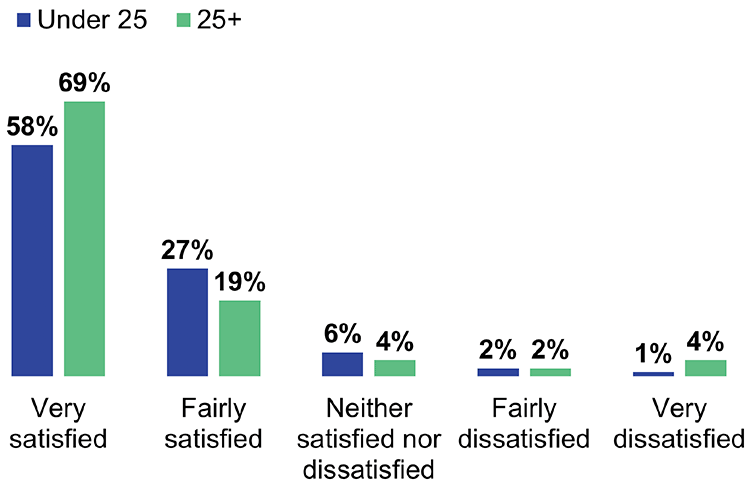
Source: Ipsos survey of service users
Base: Under 25 (271); Over 25 (433)
These high levels of satisfaction were also reflected in the feedback from service users who were interviewed, who referenced the holistic, tailored and person-centred nature of support. Several also referenced how open, supportive and encouraging the staff delivering the services were.
"So much more than what I expected. Support was tailored to my needs, they took my circumstances into account and didn't encourage me to go for the first job that came up but wanted me to get something that was a good fit. My key worker really lit a fire in me to find work. I changed my whole perspective and I was like I can do this, and I'm now working."
(Service user)
"It wasn't just always about what they could do to get you employed, there was also a bit of emotional support as well. They do go above and beyond. They weren't judgemental, especially with my personal situation. They weren't critical at all. They were just very sympathetic and generally lovely. I spoke to a few of the team and I couldn't fault any of them."
(Service user)
Key themes amongst those who were dissatisfied with the service related to the time taken to access particular types of support, such as work placements, and a lack of responsiveness. Some service users thought the services seemed understaffed, which reflects feedback from some staff referenced in the previous chapter (see Figure 4.5).
"I wanted a placement with the council but was told I had to be unemployed for 12 months to be eligible. I felt that was a long time for someone who is eager and keen. Waiting 12 months is soul destroying, they could open that door sooner."
(Service user)
"I am struggling to just hear back from them at the moment. I have been in touch previously and the woman I spoke to was very nice but can't get in touch in recent months - I think they are understaffed."
(Service user)
"I feel the employment support at the moment has been lacking because the staff at [name of services] have been used in other areas of the council. The staff are just over stretched it's not their or the services fault it's just cut backs (the system)."
(Service user)
A significantly higher proportion of service users aged 55 and over were very dissatisfied with the services they received (7% compared to 1% of those under the age of 25 and 4% of those aged 25-55). The reasons for being dissatisfied mainly related to not feeling the services were suitably tailored to their needs and did not take account of their length of experience, their digital skills needs or the types of support that might be needed to enable them to re-enter the labour market.
"I know where to look for services but there's not much for the older age group. A lot of services are aimed at younger people. Need more for older age groups. Older people need same amount of support. It's daunting for people coming out of long-term care or a break. More access to training that helps brush up skills that are rusty because you haven't used them. Everything is computer based, there is a generation that didn't grow up with that."
(Service user)
"Everything seemed to be for youngsters, not for people over 60. Annoying, frustrating. When you get to 59 you can't apply for training and grants. I feel older people are written off despite having 30 or 40 years' experience."
(Service user)
People who accessed employment services in 2021 and 2022 were more likely to be satisfied with the support received than those who accessed services in 2019. Nine in every ten (90%) survey respondents who accessed services in 2022 and 91% of those who accessed services in 2021 were satisfied with the support received, significantly higher than the equivalent figure of 75% for those who accessed services in 2019. Conversely, one in every ten service users who accessed employability support in 2019 were very dissatisfied with the support received (11%), which was significantly higher than the equivalent figure for those who accessed services in 2021 and 2022 (both 2%). A range of reasons were provided as to why they were very dissatisfied with poor / unhelpful service being the most common.
Extent to which service met user needs
Most service users thought the support they received had met their needs. Nine in every ten (90%) of those aged 25 and over thought the employment services had met their needs to at least some extent, with most (67%) saying it had met their needs to a great extent. Service users who were under the age of 25 were slightly less likely to say that the services had met their needs to a great extent, but still 87% thought it had met their needs to at least some extent. No significant differences were observed between service users with or without a disability or long-term health condition, from different ethnic backgrounds, who were care experienced, single parents or those with or without a conviction.

Source: Ipsos survey of service users
Base: Under 25 (271); Over 25 (433)
Service users who accessed support in 2019 were significantly more likely to say that the services had hardly at all or not at all met their needs (14% compared to 5% in 2022). Again, suggesting that those who had accessed services more recently (after the introduction of No One Left Behind) have had a more positive experience of the support received.
Alignment of services to No One Left Behind principles
Feedback from service users suggests that employment services are being delivered in close alignment to these principles and commitments. Around nine in every ten survey respondents agreed that the services they accessed had treated them with dignity and respect, treated them fairly and without discrimination, respected their privacy, treated them as an individual, were patient and kind, considered how they might feel, listened to them, were flexibility to meet their needs and accessible. Around two thirds strongly agreed with each of these statements and between 6-8% disagreed.

Source: Ipsos survey of service users
Base: All (713)
Most service users further agreed that the support they accessed was delivered by knowledgeable staff, made communications simple and clear, was tailored to their needs, recognised their existing experience and current situation and were easy to access and engage with (Figure 5.10). Most also agreed that the services worked in partnership with other organisations and were easy to find, although the proportions agreeing with these two statements were lower than for the others mostly because service users did not have an opinion either way (neither agreed nor disagreed) or didn't know.

Source: Ipsos survey of service users
Base: All (713)
Service users who participated in interviews provided further feedback that the services they accessed had treated them with dignity and respect. They discussed being treated as an individual and not feeling pressured or forced to apply for training or jobs that did not align with their aspirations or would be unsuitable due to caring responsibilities. They appreciated that the support offered was holistic and tailored, taking account of wider issues they were facing.
"It was exactly what I needed. I felt it was person centred - every time we caught up it was not just about the application form. She asked how I was getting on. Made me feel like a real person."
(Service user)
"I felt bereaved losing my job after 33 years during Covid-19. She recognised I was distraught and she was very respectful. It was most important to me that she treated me with dignity and respect."
(Service user)
"I liked the humanness of it, I was treated as an individual. The key worker was really good, really helpful and willing to research things if they didn't know the answer."
(Service user)
"She took into consideration what I was saying. I wanted weekly contact over the phone. If I checked in weekly, I wouldn't lose motivation. I was offered face to face but decided against it because of travel costs and fitting in around school but having the option was good."
(Service user)
A significantly higher proportion of single parents strongly disagreed that employment services treated them with dignity and respect (10% compared to 5% of those who were not single parents). Single parents were also more likely to strongly disagree that services respected their privacy (9% relative to 4% of those who were not single parents). However, single parents were more likely to strongly agree that the employment services they accessed worked in partnership with other organisations (57% relative to 46% for those who were not single parents).
Interviews found some differing experiences of disabled service users or those with a long-term health condition in the support they received.
"If someone has health issues they need extra support – I felt that was available."
(Service user)
"The centre was not geared up for disabled people. Central heating on full blast and chairs not good. Sitting can be uncomfortable so makes training difficult. Doesn't help or encourage you."
(Service user)
People who accessed services in 2021/22 were significantly more likely to say they had been treated with dignity and respect than those who accessed services in 2019. Nine in ten service users (90%) who accessed support in 2021 or 2022 agreed they had been treated with dignity and respect compared to 79% who had accessed services in 2019. Similarly, around nine in ten service users who accessed support in 2021 or 2022 (91% and 90% respectively) agreed that the services had treated them fairly and without discrimination – significantly higher than the equivalent figure of 75% for those accessing services in 2019.
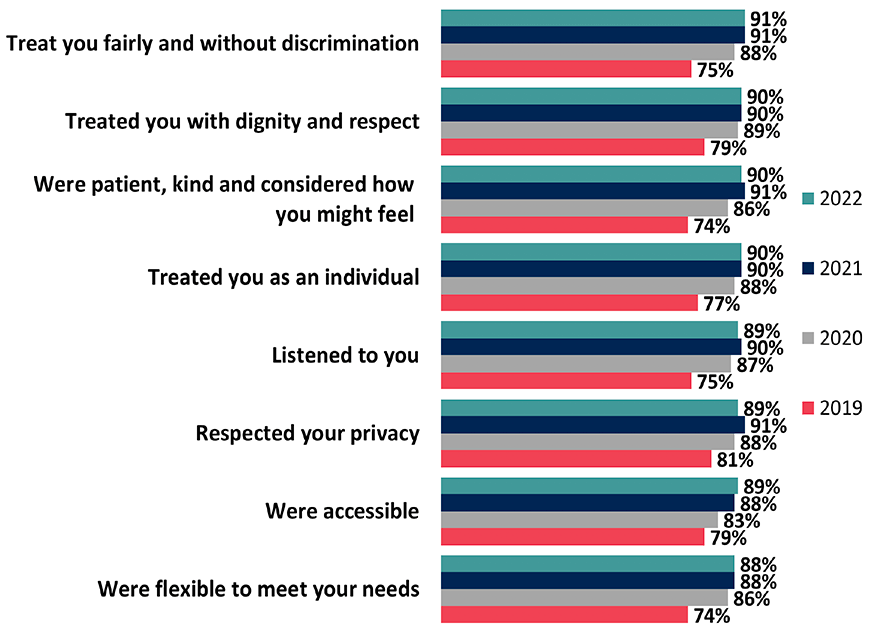
Source: Ipsos survey of service users
Base: All (713)
Figures show the % who agreed or strongly agreed with each statement
Service users who participated in interviews also highlighted noticeable differences in their experiences of accessing employment services more recently compared to when they had accessed services previously.
"I've had some [bad experiences] in the past. Felt they were trying to hit targets and not listening to what was suitable for you. It used to make me feel like I'm not capable of anything. My current mentor is really supportive. When asked about extra training before the day's out she got it arranged. She champions all her placements, goes the extra mile."
(Service user)
"They're so understanding this time around. I like the social aspect. Nice atmosphere, I don't feel pressured into things."
(Service user)
"100% felt treated with dignity and respect, in contrast to previous experiences."
(Service user)
Opportunity to provide feedback
The Customer Charter details an expectation that employment services will actively seek feedback from service users to learn and continually improved services. Less than one third (28%) of those who completed the survey said they had been given the opportunity to provide feedback and a further half (51%) said they had not been given this opportunity. A fifth (19%) did not know. Those who were aged 25 and over were more likely to say they had not been asked for feedback (57% relative to 42% for those under the age of 25) and under 25s were more likely to say they didn't know (27% relative to 13%). There were no significant differences on this measure by gender, disability status, ethnicity, whether care experienced, whether a single parent or whether had a criminal conviction.
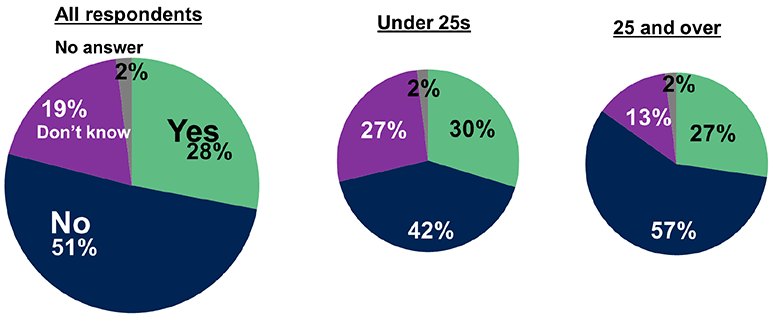
Source: Ipsos survey of service users
Base: All (713); Under 25 (271); 25+ (433)
Around half (53%) of service users said they knew how to complain if they were unhappy with the support received, one in three (30%) said they did not and 18% either didn't know or did not answer. Those under the age of 25 were more likely to say they knew how to complain than those aged 25 and over (60% relative to 48%).
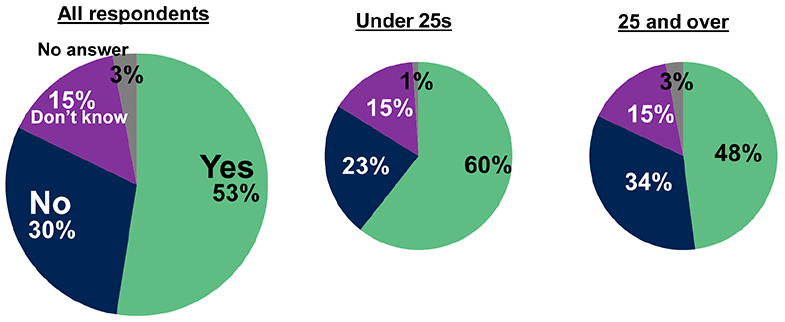
Source: Ipsos survey of service users
Base: All (713); Under 25 (271); 25+ (433)
5.4 Outcomes
Intermediate outcomes
As referenced earlier in this chapter (see Figure 5.6), around half of service users were experiencing low confidence / self-esteem when they first accessed employment support services and this was holding them back from progressing in education, training and employment. Those interviewed frequently referenced the positive difference the service had made to their levels of confidence.
"The support was a confidence boost, learning how to deal with stress a bit better, not let people put me down. It was great getting my CV done because I didn't have a clue what I was doing. It was a bit daunting."
(Service user)
"Basically it turned my life around…social connectivity, meeting people again, having a reason to get out of bed."
(Service user)
"I wouldn't be who I am today if it wasn't for them helping me back on my feet and I wouldn't be doing the things I'm doing because they've helped me with my confidence."
(Service user)
Service users also shared how accessing volunteering and work experience opportunities through the services had made them feel valued and positive about the future. Most were confident that the skills and experience they were gaining would help them to progress in their employment journey.
"I enjoy been a volunteer because it's giving me the opportunity to engage and help other people. It also give me the opportunity to interact with these people and sometimes these people become friends. Volunteering helps me have a better understanding what I want to do in the future and it will give me more evidence for adding to my CV when I'm ready for work again."
(Service user)
"I enjoy getting out onsite and doing a bit of work to break the week up. It gives me a small sense of being needed and the responsibility drives me."
(Service user)
Education, training and employment outcomes
The following analysis of education, training and employment outcomes must be treated with caution and not viewed as causal evidence of impact as it does not include comparison with a control group who did not receive support to explore the counterfactual scenario.
There were notable shifts in the employment status of those accessing services through No One Left Behind pre and post engagement with the support. At first engagement with No One Left Behind services, 42% of survey respondents were unemployed and looking for work and a further 16% were in work (employed full-time / part-time or self-employed). At the time of the survey, half (51%) of survey respondents were no longer accessing employment support. Of these, 12% were unemployed and looking for work and 49% were in work (employed full-time / part-time or self-employed) on leaving the service (Figure 5.14).
There were also some shifts in the status of service users who were still receiving support. At the time of the survey, 28% of those still accessing support were unemployed and looking for work, 20% were employed part time and 8% were employed full-time. A higher proportion of those still accessing support (13%) were in training relative to those who were no longer accessing support (4%).

Source: Ipsos survey of service users
Base: Status at first engagement with the service (713); Current status (346); Status at leaving the service (367)
At the time of the survey, half (51%) of survey respondents were no longer accessing employment support. Of these, 12% were unemployed and looking for work and 49% were in work (employed full-time / part-time or self-employed) on leaving the service.
Most of those whose education, training or employment status had changed since first accessing services said the support they received had made a difference. Almost three quarters (73%) of those whose status had changed said the services had made a big difference and around one in five (18%) said it had made somewhat of a difference. A relatively small proportion thought it had made no difference (4%) or had had a negative impact (1%). Those who were over the age of 25 were significantly more likely to say that the service had made 'a big difference' to their change of status than those under the age of 25. There were no significant differences found by gender, health status, ethnicity, whether case experienced, whether a single parent or whether had a conviction
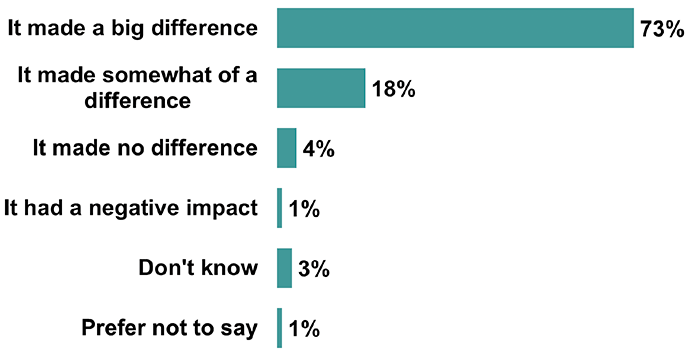
Source: Ipsos survey of service users
Base: Those whose status has changed since engaging with employment services (159)
Interviews and online diaries with service users provided further evidence that the employment support accessed had made a positive difference to their progression in education, training and employment. Service users discussed how the support had facilitated access to opportunities that they would not otherwise have considered or known about. The mechanisms for success again related to the way in which the services were delivered, which ensured users felt listened to and that their needs and interests were taken into account.
"Key benefit was getting apprenticeship. This apprenticeship has opened up a lot more doors. I didn't have proper qualifications before this. What made the most difference to me was being listened to and getting the help I actually needed, they knew what you needed."
(Service user)
"I have always been unemployed. The service emails me about upcoming courses. They helped me get on to the night course - would have struggled otherwise. I liked having someone sit down with me and explain everything. It has benefitted me a lot. Helped me go and do something. If I didn't, I would have been sitting in the house. It's helping me reach my potential."
(Service user)
"I think it's because of the support/chance they've given me. Completely changed my life around from not going out and severe anxiety/depression. Going out every day now, being happy, seeing the world in a different light."
(Service user)
"I'm really enjoying seeing the progress we have made and it makes me feel proud that we have nearly completed the job in good time… This job is allowing me to work on many personal skills, such as team working, time keeping and efficient working."
(Service user)
5.5 Recommendations from service users
Service users who participated in interviews were asked if they had any recommendations as to how they thought employment services in Scotland could be further developed or improved. Suggestions put forward by service users included more promotion and advertisement of the services and what they offer, including through outreach work. It was also suggested that more could be done to make people aware that they can access support online and to create more online opportunities for training, volunteering and work placements, which would help some service users overcome barriers relating to access to transport, which is a particular challenge for those living in rural areas and / or with childcare responsibilities.
Other suggestions put forward by service users included expanded services to ensure that everyone has access to everything they might need to enable them to progress and more support tailored to the specific needs of particular groups, such as army veterans, older people, disabled people and those with health conditions.
Contact
There is a problem
Thanks for your feedback